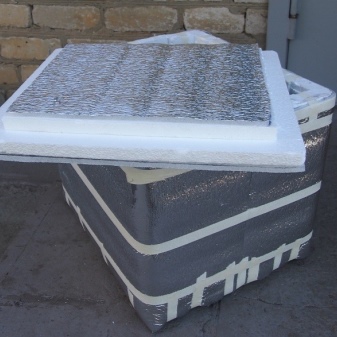Features of foam boxes

Foamed polystyrene foam (polystyrene) has been actively used in the construction industry for many years. Recently, however, this material has been increasingly used for the manufacture of special containers in which various goods are stored and transported, including food.

Advantages and disadvantages
Such widespread foam boxes have received due to the impressive list of their advantages.
- Tightness... Expanded polystyrene does not allow dust, steam and moisture to pass through, due to which the contents of the box remain dry and clean, or, conversely, does not dry out in a warm room.
- Thermal insulation... In containers with a lid, cold food stays fresh for a long time, while hot food retains its temperature for about a day.
- Styrofoam does not interact with content, does not have its own smell and does not absorb the smell of objects lying in it.
- With a very affordable price such containers serve for a very long time.
- They are pretty sturdyto stack them on top of each other for transport, while keeping their own weight to a minimum.
- Expanded polystyrene does not rot, does not rust and is easy to clean with plain water... It does not contain substances harmful to humans. The special food grade foam can contact all foods safely.

Among the disadvantages of foam boxes, there are only three.
- They are not resistant to mechanical damage... They are easy to scratch, pierce with sharp objects or corners of metal containers.
- Material starts to crumble under prolonged exposure to direct sunlight.
- The main enemy of foam containers is rodents. If mice are in the cellar or closet, they will begin to gnaw the corners and walls of such a box.

Views
Manufacturers offer several types of foam containers for sale.
- Such boxes may differ from each other in terms of volume.... There are very small containers - from 1 to 3 liters. There are more spacious boxes with a volume of 5 or 10 liters. And also large containers, most often used in industry, from 20 to 100 liters.
- Containers may vary in shape... These can be round or rectangular boxes, as well as boxes of other shapes, made to order. On sale there are whole sets of foam boxes of different sizes and shapes that can be purchased for home use.
- And finally, foam containers can vary depending on the purpose.... For example, there are boxes for transportation, storage and temperature maintenance.


Applications
First of all, the foam is used by freight forwarding companies. Most often for the transportation of glass products, medicines, plants, complex equipment or other fragile goods. These boxes are often used for storing vegetables, fruits or even seafood.
The main advantage when storing chilled fish is that the foam does not absorb its specific flavor.

They are very convenient for storing potatoes on the balcony in winter and autumn. In addition, foam boxes are often used as fishing boxes for winter fishing and as small homemade refrigerators in the country. To do this, they must be equipped with a tight-fitting lid.
How to do it yourself?
It is not at all difficult to make a thermo box from polystyrene with your own hand. The main thing – get a mesh plastic box from under vegetables or fruits in advance to use it as a base. Such boxes can be given away for free or for a symbolic price at the nearest grocery store or market.

In addition to such a plastic frame, you will need:
- insulation;
- Styrofoam;
- adhesive composition;
- sharp knife or scissors;
- foam rubber;
- masking tape.

Styrofoam is best taken in flat sheets, so it is more convenient to cut it. As an adhesive, a special glue is best suited for gluing polystyrene foam panels to the ceiling or walls.
Step by step, the whole process of assembling a foam mini-refrigerator is as follows.
- The inner surface of the box is lined with insulation... The tighter the pieces of insulation are fitted at the joints and in the corners, the better the thermal insulation properties of the container will be.
- The outer surface of the box is covered with foam, starting from the corners. If the amount of material is limited, you can stop at creating a foam frame, pasting only the edges of the plastic container, and filling all the voids between the insulation and the foam with pieces of foam rubber.
- Outside, the resulting foam box is also wrapped with insulation, which is fixed with masking tape.



The open box is ready, but without a tight lid, it will not maintain the temperature. The lid is also easy to make.
- Two rectangles are cut from the foam plates, one of which is the same size as the inner size of the resulting box, and the second exceeds it by 5 cm on each side.
- Two rectangles are glued together, and their lower and upper surfaces are pasted over with insulation.


The temperature of the food in such a box is maintained for about 18-20 hours. This allows you to use it not only for storing vegetables in the pantry, but also to take it with you on a trip as a large thermal bag for a hot lunch or soft drinks.
For information on how to make a cold foam box, see below.













The comment was sent successfully.